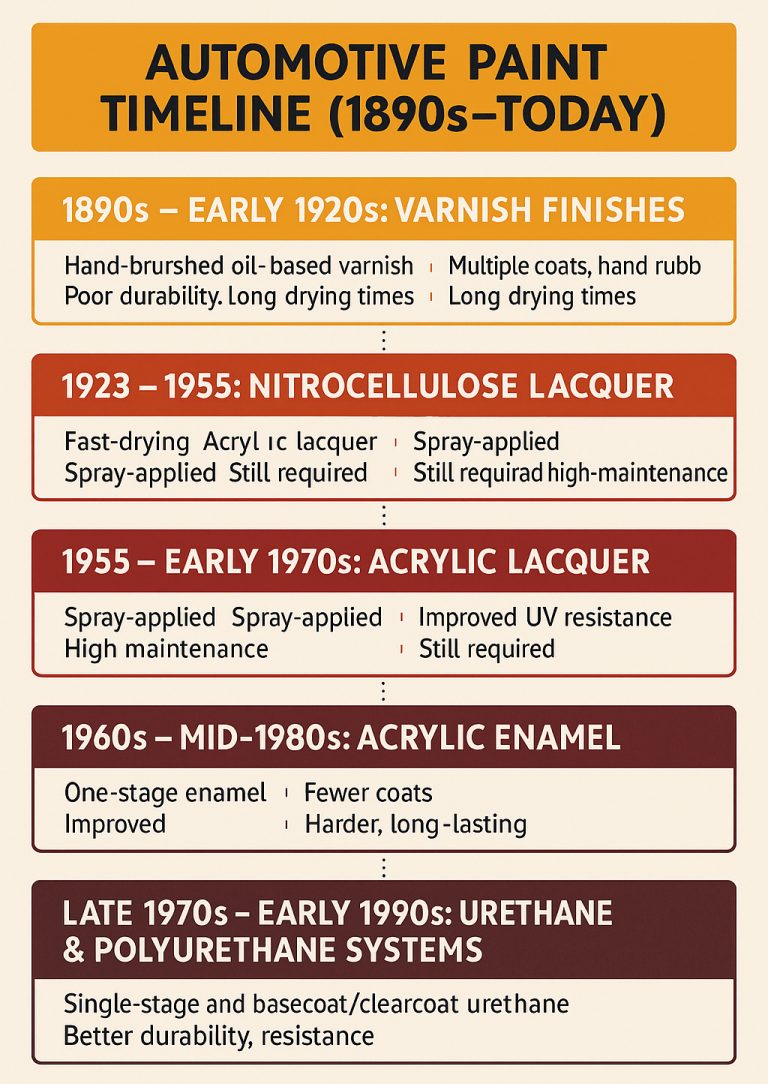
🚘 Automotive Paint Timeline (1890s–Today)
🪵 1890s – Early 1920s: Varnish Finishes
Type: Hand-brushed oil-based varnish (copal, linseed oil, shellac)
Application: Multiple coats (10–20), hand-rubbed
Dry Time: Days to weeks
Durability: Poor (UV damage, cracking)
Used on: Wood-bodied vehicles and early steel panels
Downfall: Too slow and labor-intensive for mass production
💥 1923 – 1955: Nitrocellulose Lacquer
Introduced by: DuPont in 1923 (“Duco”)
Type: Fast-drying lacquer derived from gun cotton chemistry
Application: Spray-gun applied, multiple thin coats, hand-buffed
Dry Time: Minutes to hours
Durability: Glossy but prone to fading, cracking, and yellowing
Used by: All major U.S. manufacturers
Bonus: Easy to repair, blend, and polish
Downfall: Required frequent upkeep and had low chemical resistance
🎨 1955 – Early 1970s: Acrylic Lacquer
Introduced by: GM in 1955 (DuPont “Lucite”)
Type: Chemically improved lacquer with better UV resistance
Application: Same as nitrocellulose, but higher gloss and less fading
Used by: GM (Cadillac, Olds), then others followed
Durability: Slightly better than nitrocellulose but still required upkeep
Downfall: Environmental regulations and better alternatives on the rise
🧴 1960s – Mid-1980s: Acrylic Enamel
Type: One-stage enamel (color and gloss in one layer)
Curing: Air-dry or bake (thermoset version used in factories)
Application: Fewer coats, faster production, high-gloss finish
Used by: Ford, Chrysler, GM — industry standard in this era
Durability: Harder and longer-lasting than lacquer
Downfall: Difficult to repair and blend; environmental concerns
🛡️ Late 1970s – Early 1990s: Urethane Enamel & Polyurethane Systems
Type: Single-stage urethane or basecoat/clearcoat urethane
Introduced: Late 1970s (PPG, DuPont, BASF innovations)
Application: More durable, chemical-resistant, and glossy
Basecoat/Clearcoat (BC/CC): Two-step system became standard
Basecoat: Color
Clearcoat: Gloss and protection
Used by: All major automakers by mid-1980s
Durability: Excellent — resists UV, scratches, and chemicals
Downfall: More expensive and complex for DIY use
🌍 1990s – Present: Modern Urethanes, Waterborne Systems, and Low-VOC
Basecoat/Clearcoat urethane: Industry standard today
Waterborne basecoats: Introduced due to EPA VOC regulations
Common systems:
2K urethane (catalyzed, two-component)
Waterborne base + 2K urethane clear
Durability: Outstanding, can last decades
Used by: All OEMs worldwide
Shifts:
Low-VOC formulas to meet environmental laws
Ceramic clears and self-healing topcoats in luxury cars